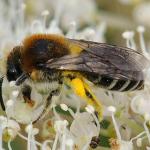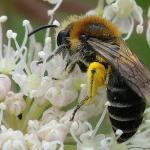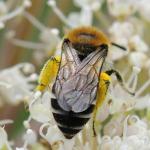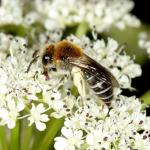Colletes montanus MORAWITZ 1876; Colletes suecica AURIVILLIUS 1903; Colletes kudiensis COCKERELL 1924; Colletes yasumatsui HIRASHIMA & IKUDOME 1989
This species was originally found for the first time in the British Isles in south-west Scotland in July 1899 (Saunders, 1899), the record being published under the name Colletes montanus). However, it is most widely distributed in the Western Isles and especially in Ireland. Indeed, it is the only bee that is more widespread in that country than in Britain. On mainland Scotland this mining bee has been recorded from Dumfries and Galloway (Tons Warren), Argyll (Macrihanish Dunes, Kintyre (S Miles pers. comm.)) and Strathclyde (Irvine Moor, near Ayr). It is still present (2010) at Irvine Moor (B & S Little, pers. comm.). However, it is more widely distributed on the islands off the west coast: Colonsay and Tiree (Strathclyde), and Barra, South Uist and Benbecula (Western Isles). Published, but unconfirmed, records of Colletes daviesanus from Pabbay north to Lewis (Western Isles), and from Coll, Tiree and Rum (Heslop Harrison 1952) almost certainly refer to C. floralis. In England, the bee was collected at Sandscale Haws, Cumbria, by M E Archer on 18 July 1994 (the first English record). The species is very widely distributed on the coast of Ireland, with records from Dublin, Wicklow, Wexford, Waterford, Cork, Kerry, Clare, Galway, Mayo, Sligo, Donegal and Derry. The bee has also been found on the islands of Cape Clear (Cork) and Great Saltee (Wexford). In addition, it is known from some inland sites in Wexford, Kilkenny, Galway and Cavan.
Not listed in the British Red Data Book (Shirt 1987), but Falk (1991) has proposed that it should be included in future editions as Rare (pRDB3).
Mainly coastal sand dunes and, in the Western Isles, the machair (a maritime grassland typical of the Hebrides, comprising a rich flowering sward established on wind-blown shell sand). In Ireland, the species has been found nesting in sandy clays along cliffs, in marram dunes and in the interstices of the masonry of a bridge (Stelfox, 1927, 1933).
Single-brooded; mid-June to early August.
A typical mining bee, excavating its nesting burrows in expanses of bare or very sparsely vegetated, firm sand. The burrows often occur in aggregations and, on South Uist, were flush with the surrounding soil, there being no tumuli around the burrow entrances (pers. obs.). Irish habitat includes sandy clays along cliffs, marram dunes and, formerly, in the interstices of the masonry of a bridge (Stelfox, 1927, 1933). In Ireland, nest burrows have also been found on an exposure of flat loose sand within a pine plantation in Co. Wexford (pers. obs.).
Fiedler (unpublished) reported that on the Scottish island of Islay, males were found nectaring at Rosa pimpinellifolia (Rosaceae); Thymus sp. (Lamiaceae); Cirsium arvense, Cirsium vulgare (Asteraceae) and females were nectaring at Cirsium arvense, Cirsium vulgare (Asteraceae) and Galium verum (Rubiaceae).
Other flower visitiation records are of visits to white clover (Trifolium repens), bird's-foot-trefoil (Lotus corniculatus), bramble (Rubus sp.), cinquefoil (Potentilla sp.), biting stonecrop (Sedum acre), sea-holly (Eryngium maritimum), water-dropwort (Oenanthe crocata), wild angelica (Angelica sylvestris), hogweed (Heracleum sphondylium), wild carrot (Daucus carota), heath (Ericaceae), thyme (Thymus sp.), sheep's-bit (Jasione montana) and cat's-ear (Hypochoeris radicata).
Profile prepared: 1998
Updated January 2012





